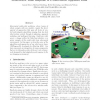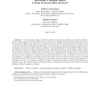603 search results - page 67 / 121 » Motion Planning for Multiple Robots |
ATAL
2010
Springer
13 years 9 months ago
2010
Springer
The central problem of designing intelligent robot systems which learn by demonstrations of desired behaviour has been largely studied within the field of robotics. Numerous archi...
ICRA
2003
IEEE
14 years 1 months ago
2003
IEEE
Adversarial multi-robot problems, where teams of robots compete with one another, require the development of approaches that span all levels of control and integrate algorithms ra...
TSMC
2002
13 years 7 months ago
2002
This paper proposes a new trajectory generation method that allows full control of transient behavior, namely, time-to-target and velocity profile, based on the artificial potentia...
IROS
2009
IEEE
14 years 2 months ago
2009
IEEE
Abstract— This work presents the control of multiple untethered rectilinear magnetic micro-robots (Mag-µBots) with dimensions 250 × 130 × 100 µm3 actuated by pulsed external ...
AR
2004
13 years 7 months ago
2004
-- An inevitable collision state for a robotic system can be defined as a state for which, no matter what the future trajectory followed by the system is, a collision with an obsta...


